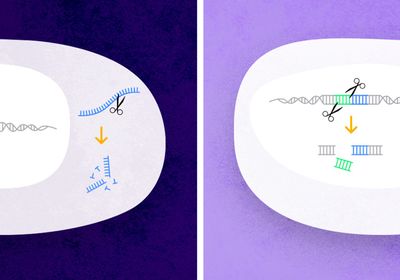What’s the Difference Between Gene Knockdown and Gene Knockout?
There are many techniques that allow scientists to silence a gene, but whether the effect is transient or permanent depends on the type of approach.
Researchers can experimentally interrogate the function of one or more genes using knockout or knockdown tools. Although both approaches ultimately interfere with gene function, knockout and knockdown techniques accomplish this through distinct mechanisms that operate at different levels.
Gene Knockdown: A Short-term Trick
Gene knockdown reduces the expression of a gene at the RNA level. Scientists often employ RNA interference (RNAi) and clustered regularly interspaced short palindromic repeats interference (CRISPRi) methods to accomplish that goal. While RNAi exploits the naturally occurring RNAi pathway used by cells to identify and target a specific messenger RNA for degradation, CRISPRi binds to the DNA and blocks either transcription initiation or elongation depending on the region it binds to.1,2 Since both techniques act at the transcript level, there are no changes in the DNA sequence of the gene, leading to a transient phenotypic effect. Researchers opt for this temporary gene silencing when studying genes that are essential for the development of an organism and whose deletion could be lethal.
Gene Knockout: Altering the Genetic Blueprint
Gene knockout approaches completely ablate gene expression at the DNA level.3 Researchers can accomplish this by using genome editing tools, such as zinc finger nucleases (ZFN), transcription activator-like effector nucleases (TALEN), and CRISPR and its associated endonucleases.4-6 These tools produce double-strand breaks at specific DNA sites, which the cell tries to fix using an error prone repair mechanism that can alter the sequence of the target gene. As knockout tools result in a sustained gene silencing, they eliminate confounding effects that might remain after gene knockdown.
- Agrawal N, et al. Microbiol Mol Biol Rev. 2003;67(4):657-685.
- Larson MH, et al. Nat Protoc. 2013;8(11):2180-2196.
- Zimmer AM, et al. J Exp Biol. 2019;222(Pt 7):jeb175737.
- Urnov FD, et al. Nat Rev Genet. 2010;11(9):636-646.
- Joung JK, Sander JD. Nat Rev Mol Cell Biol. 2013;14(1):49-55.
- Sternberg SH, Doudna JA. Mol Cell. 2015;58(4):568-574.


